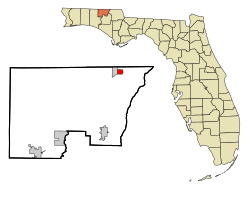Noma, Florida | |
|---|---|
 Location in Holmes County and the state of Florida | |
| Coordinates: 30°58′54″N85°37′10″W / 30.98167°N 85.61944°W | |
| Country | |
| State | |
| County | Holmes |
| Settled | 1882 [1] |
| Incorporated | July 1904 [1] [2] |
| Reincorporated | 1977 [2] [3] |
| Government | |
| • Type | Mayor-Council |
| • Mayor [2] | Literman Joseph |
| • Vice Mayor | Coy Mixon |
| • Councilmembers | Josephine Curry, Betty Forthman, and Daniel Arrant |
| • Town Clerk | Ben Tew |
| Area | |
• Total | 1.09 sq mi (2.83 km2) |
| • Land | 1.07 sq mi (2.76 km2) |
| • Water | 0.03 sq mi (0.07 km2) |
| Elevation | 180 ft (55 m) |
| Population (2020) | |
• Total | 208 |
| • Density | 194.94/sq mi (75.25/km2) |
| Time zone | UTC-6 (Central (CST)) |
| • Summer (DST) | UTC-5 (CDT) |
| ZIP code | 32452 |
| Area code | 850 |
| FIPS code | 12-48900 [5] |
| GNIS feature ID | 0287758 [6] |
Noma is a town in Holmes County, Florida, United States. The Town of Noma is part of the Florida Panhandle in North Florida. The population was 208 at the 2020 census.

